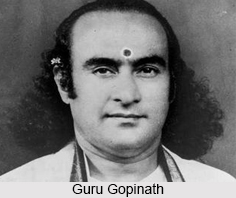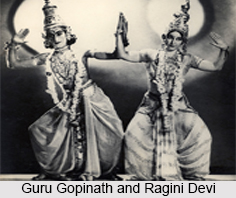 Guru Gopinath, also known as Perumanoor Gopinathan Pillai was an eminent Kathakali dancer, innovator and scholar. He is regarded as the greatest preserver of the dance tradition. He had invented a new form of dance that he named "Kerala Natanam" and reduced the long rigorous course of Kathakali.
Guru Gopinath, also known as Perumanoor Gopinathan Pillai was an eminent Kathakali dancer, innovator and scholar. He is regarded as the greatest preserver of the dance tradition. He had invented a new form of dance that he named "Kerala Natanam" and reduced the long rigorous course of Kathakali.
Early Life of Guru Gopinath
Guru Gopinath was born on 24 June 1908 in Champakulam village in Alappuzha district of Kerala. His parents were Madhavi Amma and Kaippilli Sankara Pillai. He was the younger brother of Champakulam Pachu Pillai.
He was initially trained under great masters of Kathakali like Champakulam Paramu Pillai, Mathoor Kunjupilla Panicker and Thakazhi Kesava Panicker at Champakulam. Then he received training from Natyaacharya Padma Shri Mani Madhava Chakkiyar in southern style of acting in Kathakali, which gives importance to Abhinaya. His main teacher was Guru Kavalappara Narayanan at "Kerala Kalamandalam" where he was asked to join as a special student for higher studies in northern style. He took lessons in Abhinaya (acting) from Guru Kunchu Kurup.
Career and Works of Guru Gopinath
Guru Gopinath developed a shorter syllabus and duration of training for Kathakali under which the 12 years Kathakali course was reduced to 6 years, without deviating from its classical tradition. He also invented a new form that he named "Kerala Natanam" meaning Kerala Dance, premiered in 1934 at Kottayam. His spectacular achievements began in 1936 when he joined the famous American dancer Ragini Devi to tour worldwide. In a sense, he gave Kathakali much needed exposure. Kathakali style of dancing and training was a male monopoly. It was Guru Gopinath who experimented and proved that girls can perform Kathakali. Rabindranath Tagore happened to see him perform and said that none equalled him in the perfection of art.
Guru Gopinath"s facial expressions were wonderful. He was one such artist who could show the nuances of the nine emotions in Kathakali and he could show different emotions on each half of his face at the same time. He proved Kathakali"s flexibility by introducing major changes in costumes. He copied the crowns and dresses of Gods and Goddesses as seen on statues in different temples, which art lovers welcomed. Appointed as palace dancer by the Travancore Maharaja, he resigned later to lead productions throughout India.
 Books by Guru Gopinath
Books by Guru Gopinath
Guru Gopinath has written books in Malayalam and English, which explain theory and practise of Indian and Kerala dances. He wrote many books, such as:
•"Natana Kairali" i.e. Dance of Kerala
•"Abhinayaprakasika" i.e. Expression of Abhinaya
•"Talavum Natanavum" i.e. Tala and Dance
•"Abhinayankuram" i.e. Seedling of Abhinaya
•"Kathakalinatanam" i.e. Kathakali Dance
Honours and Awards Conferred to Guru Gopinath
The "Guru" status was awarded later by Indian People"s Theatre Association (IPTA). Following are the achievements of Guru Gopinath:
•He was awarded the "Veera Srumkhala" from Chithira Thirunal Balarama Varma, the King of Travancore.
He was honoured with a doctorate by Rabindra Bharathi University.
•His statue was erected in Viswa Bharathi University.
•He is a recipient of the Sangeet Natak Akademi Award.
The Kerala Government has established a dance village named "Guru Gopinath Natanagramam" in Trivandrum. The village has a three-storey dance museum dedicated to him.
Personal Life of Guru Gopinath
Guru Gopinath was married to the great Mohiniyattam dancer and exponent of Kerala Natanam – Mulakkal Thankamani Amma. They have four children; three daughters and a son. Their eldest daughter is Vasanthi Jayaswal, a dancer and social worker. Their second daughter was Vilasini Ramachandran, a Senior I.A.S. officer in Gujarat. The youngest daughter Vinodini Shashimohan was a child artist in Malayalam movies in the 60s and she is now the Chief Administrative Officer of Viswa Kala Kendra, Trivandrum. G. Venugopal is his only son.
Death of Guru Gopinath
Guru Gopinath breathed his last in 1987. He died on stage, as he wished, with makeup, attire and anklets while enacting the role of King Dasharatha in his famous ballet "Ramayana" at Fine Arts Hall, Ernakulam.



















